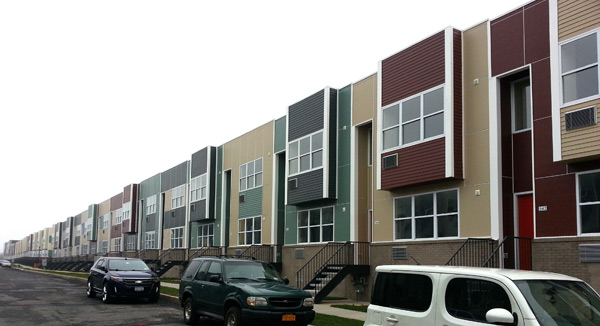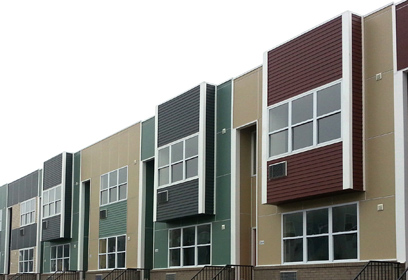
New developments such as Spring Creek in East Brooklyn aim to update affordable housing. Photograph: Matt Green
When Bill de Blasio spoke last month to elated supporters on the night of his victory in New York’s mayoral election, he returned to themes that had driven his campaign:
I’ve spoken often about a tale of two cities. That inequality—that feeling of a few doing very well, while so many slip behind—that is the defining challenge of our time. . . . So when we call on the wealthiest among us to pay just a little more in taxes to fund universal pre-K and after-school programs we aren’t threatening anyone’s success. . . . When we demand that big developers build affordable housing, and fight to keep our hospitals from becoming luxury condos, it’s not to punish the real estate industry.
The attempt to fund universal pre-K will be resisted fiercely by the wealthy New York establishment, in part because it does see any new tax as a threat to its success. It won’t matter that New York City is far behind Oklahoma, one of the redder red states on this issue, or that bankers, economists, and other moderates and conservatives consider early childhood education the most effective contributor to future employment. The rich will recruit de Blasio’s former boss, Governor Andrew Cuomo, who has mastered the modern Democrat’s two-step: high-profile support of socially liberal demands such as marriage equality, coupled with consistent opposition to economically progressive ideas such as raising taxes to support education.
Resistance to a small tax increase will not only affect the new mayor’s education plans, but it may also distract him from the second part of his election-night message: real estate development for working- and middle-class people.
Even in our global, virtual age, local property is critical. National and international shifts—toward intellectual, cultural, and educational work, primarily—have their effects, but thanks in large part to real estate, cities aren’t passive victims, or at least don’t have to be. Cities are still physical places, and their available space—abandoned sites, brownfields, public lands, buildings of all kinds—is tremendously valuable. Real estate owned and regulated by cities remains central to the fortunes being amassed in New York, Boston, Washington, D.C., lakefront Chicago, and elsewhere.
Every major developer, construction company, global investor, financial institution, and building-materials supplier understands this. They understood it decades ago, when I was starting out as an organizer in the housing field. Thirty years ago, I sat down for coffee with a Chicago developer visiting New York and asked what he’d been doing. “Walking,” he said. He’d spent the previous two weeks walking every block in Manhattan looking for potential sites. I admired that relentless drive and attention to detail, which developers maintain today. Investors from Australia are buying into Bushwick, Brooklyn, the latest front line in the gentrification fight. Boston’s Chinatown, long strangled by an abutting highway and left behind as the city’s poorest neighborhood, is being bought up by—who else?—wealthy Chinese.
Though land is precious, there remains a good amount under public control—hundreds of acres in New York City, for instance, are available for new construction. This land a source of municipal strength, an opportunity to build in the public interest and to gain influence over developers. It doesn’t always work, as in Mayor Michael Bloomberg’s bungled plan to build market-rate and subsidized apartment buildings on vacant property adjacent to public housing. But responsible construction, with local support, can create many thousands of affordable units and provide cross-subsidies to support existing public-housing residents. Meanwhile, air rights, zoning changes that permit increased density in certain areas, the conversion of “industrial parks” that have not attracted an industrial job in decades—the global development community obsessively tracks all of these to see what city officials will do with the considerable power they wield.
Decisions that the new mayors of New York City, Boston, and other high-market cities make around the issue of space will determine the shape and direction of their cities for a generation or more. It is a tale of three cities, not two.
In the first city, the rich city, the already-gentrified, high-priced areas, the tendency of past mayors has been to surf the wave of new construction and rising rents often generated by major academic and medical institutions. Yes, there are battles over a block here and a building there, but, by and large, these institutions have had their way. Take NYU. If you visit Stuyvesant Town these days, you will find many apartments occupied by students whose families can pay the $4,000 monthly rent charged for non–rent controlled units. There is a critical mass of self-interests here. The university, builders, property managers, financial community, and contractors all do well. Coffee shops, fitness centers, high-end retailers, and restaurants follow or expand. The long-time residents who are subject to the market, and the religious and social institutions and corner stores that serve these residents, try to hang on or finally sell out.
But city officials are far from impotent in the face of a major institution such as NYU. Mayors in higher-market cities have leverage with which to negotiate stronger deals. For instance, new institutional building often requires zoning variances, density increases, and other concessions from cities. In exchange for concessions, cities can demand affordable-housing construction, significant payments into affordable housing trust funds, or higher wages and more full-time jobs for university or hospital employees.
City officials are far from impotent in the face of major institutions.
The second city is made up of those living in or near poverty. Take the 180,000 apartments of the New York City Housing Authority. More than 400,000 New Yorkers live in these developments. The projects are spread throughout every borough and are part of the city; they are not the reservations built in Chicago and other cities whose isolation ensured decline and eventual demolition. But even in New York, the Housing Authority has been considered a third-rate agency, where mayors parked patronage appointees and the least effective managers and staff. The same conventional wisdom that once said New York City would never be safe, would never regain the million people who left in the 1970s and ’80s, and would never improve its public transit system now says the Housing Authority cannot be stabilized and improved. Bill de Blasio’s challenge is to prove the naysayers wrong once again. The organizations of the Industrial Areas Foundations, of which I am a director, are intensely involved in negotiations with the City on how to turn public housing around. The new mayor’s first task will be to appoint an able leader to head the Housing Authority, not an election ally in search of a reward or another in a string of inept caretakers.
The third city is the one that gets overlooked and that may be most pivotal. It is neither rich nor poor. It is made up of the hundreds of working- and middle-class communities threatened by the space wars. The proper response is to try to expand these communities—to protect them from the wave of higher rents that for-profit builders and site-hungry investors generate. And a way to preserve them is to create or reinforce incentives for homeowners and building owners in those areas to upgrade or improve their properties, with the help of city subsides, so long as they maintain reasonable rent levels for tenants. New York’s Department of Housing Preservation and Development has a long history of implementing successful programs that do just that. But staffing levels there have been reduced so drastically during the Giuliani and Bloomberg years that the Department’s effectiveness has suffered. It needs to be bolstered. The other response—one that our local organizations, among many others, have promoted and implemented over three decades—is to build more affordable housing.
One of our organizations is midway through the construction of more than 1,500 affordable homes and apartments in the Spring Creek area of East Brooklyn. Yes, it is a long way from Manhattan. Yes, it is in East New York, which one former Boston mayor, after a tour in the 1970s, dubbed “the beginning of the end of civilization.” But today it is a safer community than it was then. The site we are building on is one of the largest formerly vacant sites in the city. The Bloomberg administration made a value judgment when it honored our plans for this site, which include a nearby 600,000 square foot of commercial space being handled by the private developer Related. Other for-profit developers, vying for those precious vacant lots, could not have been pleased. The new mayor will need to make scores of similar, tougher judgments of this kind. He should dedicate the first two years of his administration to the creation of nothing but affordable housing and reward the developers who follow through by granting favorable consideration on more for-profit sites in years three and four. Anything less than a tough, up-front fight to preserve and expand affordable housing for the middle city, the third city, will produce exactly what de Blasio campaigned against: an expanded gap between the very wealthy and the very poor, with fewer in the middle.
New York, which was once New Amsterdam, need only look at old Amsterdam to find a model: a city that used its will and ingenuity, over four centuries, to change its land and people, transforming watery marshes into buildable sites and disoriented immigrants into cosmopolitan locals. Cities can make decisions. Cities can set their own priorities. Cities can resist the self-interested categories of those with extraordinary wealth and an unlimited sense of entitlement. Cities can be living actions, maintaining the crucial middle of people and institutions and neighborhoods that serves as a bridge for those struggling to rise from poverty and as a brake on the adolescent appetites of the militant rich.
And the new batch of American mayors can lead that action.








